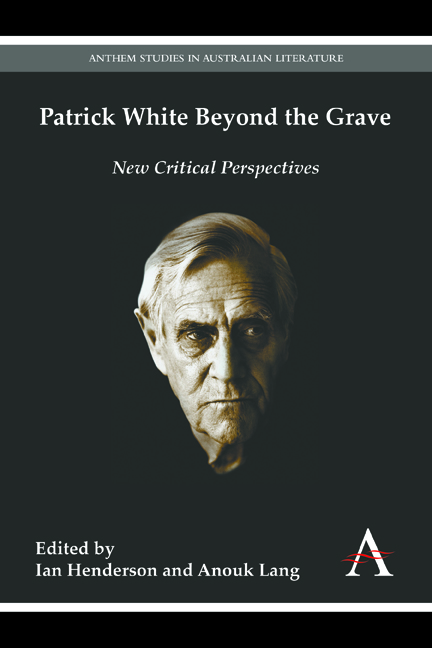Book contents
- Frontmatter
- Contents
- Acknowledgements
- Introduction
- Part I RESURRECTED PAPERS
- Part II MANY IN ONE
- Chapter 3 White's London
- Chapter 4 Elective Affinities: Manning Clark, Patrick White and Sidney Nolan
- Chapter 5 ‘Dismantled and Re-Constructed’: Flaws in the Glass Re-Visioned
- Chapter 6 Patrick White's Late Style
- Part III THE PERFORMANCE OF READING
- Part IV QUEER WHITE
- Contributors
- Index
Chapter 5 - ‘Dismantled and Re-Constructed’: Flaws in the Glass Re-Visioned
from Part II - MANY IN ONE
Published online by Cambridge University Press: 18 January 2018
- Frontmatter
- Contents
- Acknowledgements
- Introduction
- Part I RESURRECTED PAPERS
- Part II MANY IN ONE
- Chapter 3 White's London
- Chapter 4 Elective Affinities: Manning Clark, Patrick White and Sidney Nolan
- Chapter 5 ‘Dismantled and Re-Constructed’: Flaws in the Glass Re-Visioned
- Chapter 6 Patrick White's Late Style
- Part III THE PERFORMANCE OF READING
- Part IV QUEER WHITE
- Contributors
- Index
Summary
In 1939, Patrick White pondered the idea of writing an autobiography. In a letter to poet, journalist and lover Spud Johnson, he wrote:
[T]he difficult question would be: how comprehensive to make it? […] Actually, my autobiography, if a factual one, would be pretty uninteresting and bleak. I think vanity would compel me to explore its psychological possibilities, real or imagined. Just to eke out the comings and goings of fact.
Forty years later, White was ‘working fitfully on a kind of self-portrait’. By most accounts, the resultant book, Flaws in the Glass (1981) was far from ‘pretty uninteresting’. Mockingly re-dubbed ‘Claws in the Arse’, its attacks on fellow public figures, friends, family and acquaintances made frontpage news in Australia and England. But if not ‘uninteresting’, was it ‘factual’? ‘Real or imagined’? In fact, as I will argue in this chapter, Flaws in the Glass (Flaws) emerged as the climax, product, account and expression of White's lifetime search for the truth: as both a sample of White's aesthetic and a commentary upon it, Flaws provides a reading guide to his fictions. Hence, I will question the classification of Flaws as non-fiction and, more recently, as fiction, demonstrating instead that Flaws tells us not the truth but about truth.
This chapter is presented in three parts. The first questions the factuality and comprehensiveness of Flaws and critiques prior assumptions of its form and purpose. The second surveys critical approaches to the text to date and proposes an alternative: one which acknowledges and makes use of its metafictional components. The final part elucidates the complex ways in which White interweaves modes of truth in Flaws, ways which in turn illuminate his writing per se.
Flaws in the Glass Dismantle
When White's biographer David Marr first read Flaws he ‘knew it was incomplete’. Years later, Marr discovered that White's parents had invested in a publishing venture to enable his first publication, a book of poetry:
It was one of those details which completely contradicted everything that White had said about his own parents. He'd always said that they opposed his work bitterly, fought him, tried to turn him into everything except a writer, but that little detail showed me that he was in fact lying.
- Type
- Chapter
- Information
- Patrick White Beyond the GraveNew Critical Perspectives, pp. 101 - 116Publisher: Anthem PressPrint publication year: 2015



